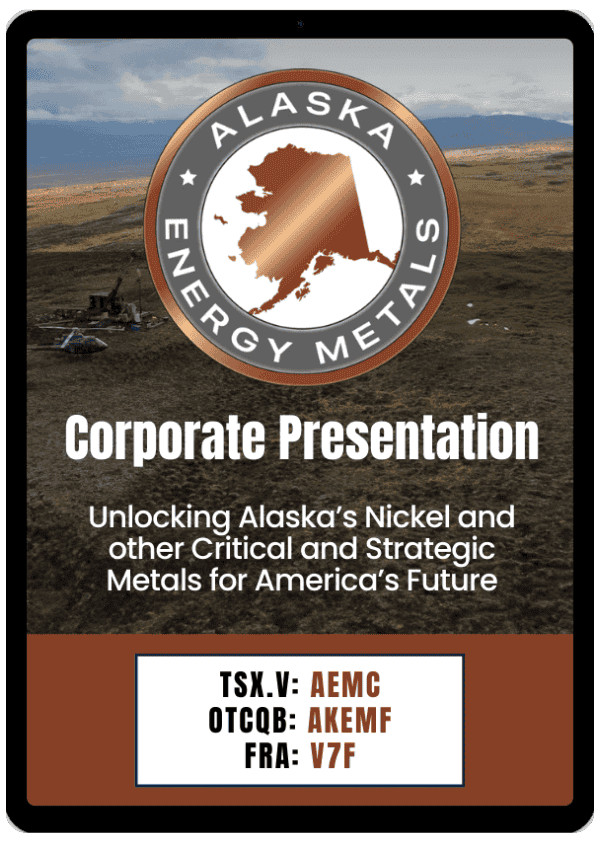Unlocking Alaska's Nickel to Drive America's Clean Energy Revolution
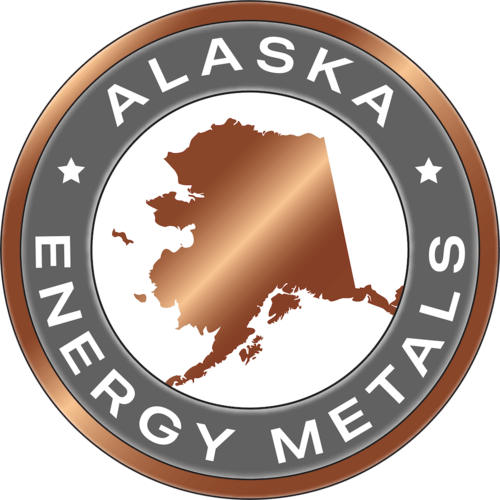
IN THIS REPORT
This content was reviewed and approved by Alaska Energy Metals and is being disseminated on behalf of Alaska Energy Metals by CarbonCredits.com for commercial purposes.
Key Takeaways:
America’s electrification effort faces an unlikely critical bottleneck: nickel. Energy transition investors usually focus on other “major” metals, like copper, lithium, and uranium. Nickel gets relegated to a niche place in the market—mostly just to keep steel from rusting.
But now that it has proven essential in high-performance EV batteries, nickel demand is rising—even while supply remains stagnant. A supply chain report produced by the Biden administration acknowledged the risk of a "large shortage of Class 1 nickel in the next 3-7 years.” The report was published three years ago.
It’s true that nickel has traditionally had industrial uses. More than two-thirds of global nickel supply is used for making stainless steel. That is changing quickly, however, as nickel has found renewed importance and a high-growth vehicle in powering the clean energy transition.
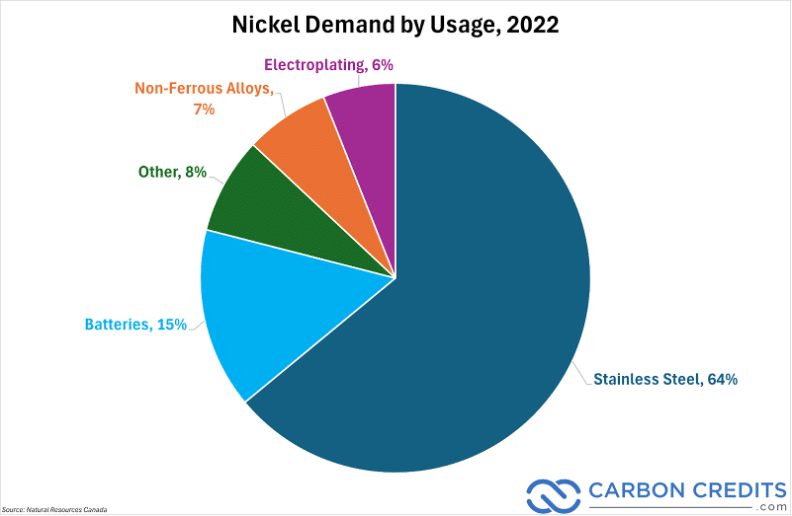
The once-ignored metal’s unique physical properties make it indispensable for most clean energy technology, including:
- EV batteries
- Battery energy storage systems
- Wind turbines
- Thermal solar plants
For some of these new technologies, nickel is necessary to create the steel. But for most of them, it enables the most effective and efficient means of storing and transferring energy: batteries.
Batteries currently make up about 10% of total demand for nickel. But in the coming years, they will rival steel in the demand for nickel. Mark Beveridge from Benchmark Mineral Intelligence says, “If we go forward [a decade or two], we’re actually looking to a future where the battery sector could provide more than 50 percent of the demand for nickel.”
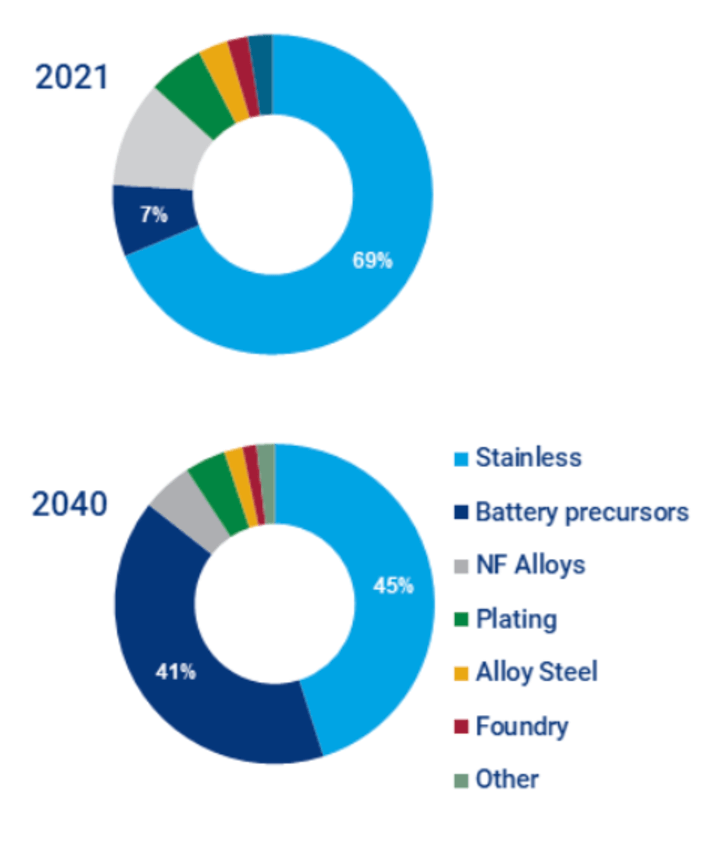
Lithium-Ion Batteries: The Great Misnomer
EV batteries are commonly referred to as “lithium-ion,” even though that’s not what they are primarily made of. The energy density and conductivity of nickel means that many battery chemistries use nickel as a majority component. The resulting batteries are lighter and hold a greater charge, making them indispensable for EV production.
Two of the most popular chemistries are nickel-manganese-cobalt (NMC) and nickel-cobalt-aluminum (NCA) lithium-ion batteries. The composition of these battery chemistries shows the importance of nickel to EVs:
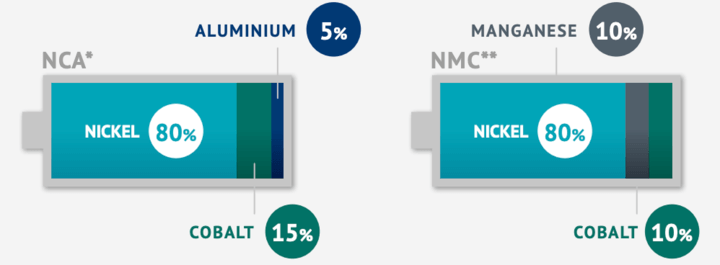
Elon Musk supports a name change for accuracy: “Our cells should be called nickel-graphite, because primarily the cathode is nickel.”
The nickel content per battery cell continues to increase, because higher nickel content equals higher energy density that enables the battery to last longer between charges. It also improves thermal stability, ensuring safer and more reliable performance across a range of temperatures.
EVs sold in 2023 used 8% more nickel than those sold in 2022. Mark Beveridge from Benchmark Mineral Intelligence says that we are “heading towards 90 percent of the cathode being nickel.”
A typical EV battery may contain:
For NMC batteries: Approximately 65-175 lb. of nickel, depending on the specific formulation.
For NCA batteries: Around 90-150 lb. of nickel.
As government policies, regulatory changes, and net-zero pledges push car manufacturers toward EV and energy storage production, nickel demand is rising.
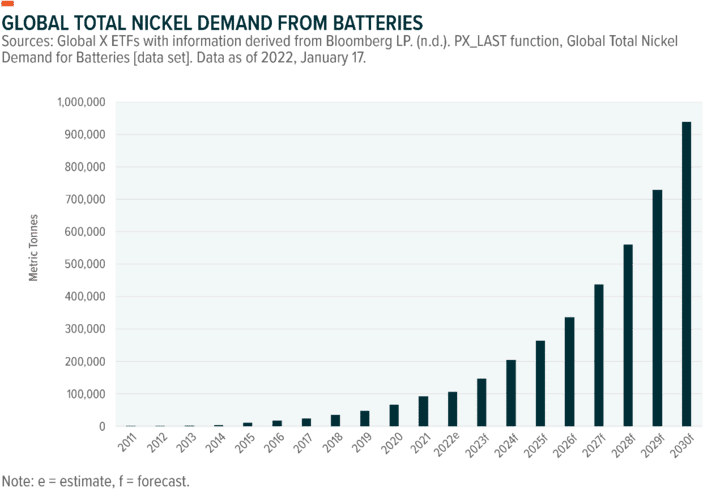
In 2022, global nickel demand stood at 3.1 million tonnes, with 478,000 tonnes attributed to the energy transition. By 2040, this is expected to rise to a total of 5.8 million tonnes, with 2.5 million tonnes of that demand coming from batteries.
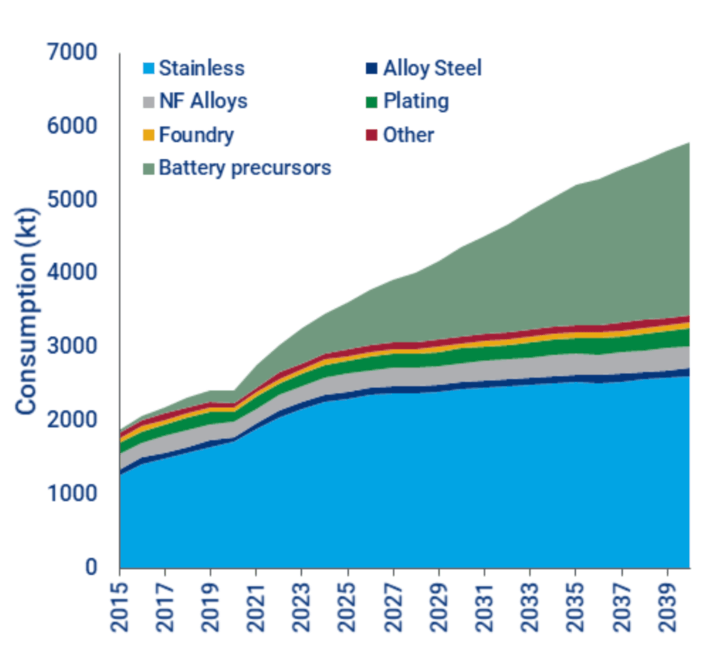
With nickel batteries requiring high and increasing amounts of the metal, it has rapidly become strategic for the energy transition. The U.S., the EU, Canada, Australia, Japan, and South Korea have all listed it as a critical mineral, indicating that it is of strong economic importance, there are no substitutes, and there is a high risk of losing supply access.
The Hidden Nickel Cartel
A decade ago, Indonesia observed an opportunity in the sudden strategic importance of nickel to the rest of the developed world. It began heavily collaborating with China—which has less than 3% of the world’s nickel reserves—to push major investment into the nickel industry.
Since 2015, Indonesia’s production of nickel has risen nearly 10-fold, from 199M tonnes to 1,800M tonnes. Last year, Indonesia produced more than half of the world’s nickel. The Philippines took second place, with only 11% of production.
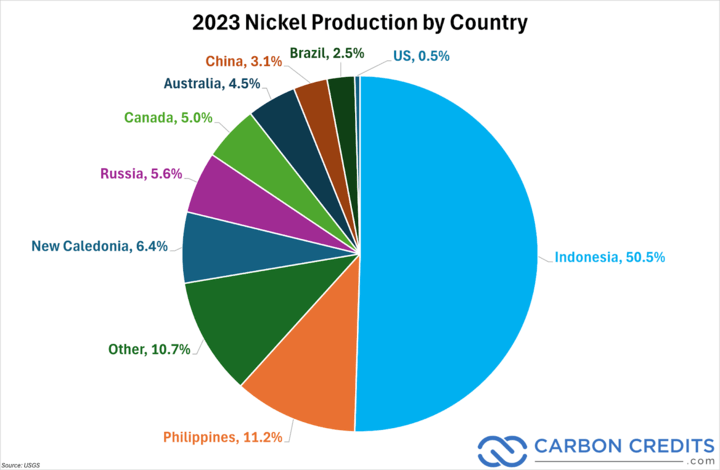
As global nickel production flags, Indonesia “is expected to be the biggest source of growth in the years ahead,” said Ewa Manthey, a commodities strategist at ING. “Production of nickel is surging to meet growing demand from the EV battery sector.”
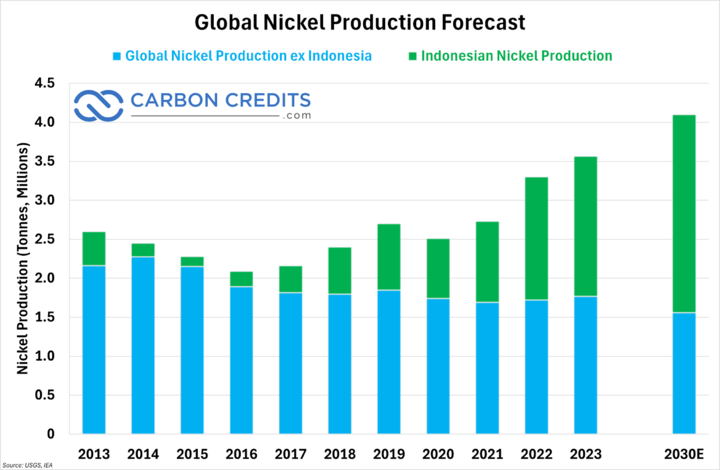
Its dominance in the industry has emboldened Indonesia to exert pressure on the global nickel market. It has already banned exports of nickel ore and brought all processing into the country’s borders to capture more of the value chain. The action brought a strong reaction from the EU in the form of a trade dispute.
It has also proposed creating an OPEC-like organization to coordinate nickel supply and move the price in its favor. Any supply tightening or further unexpected moves by Indonesia could force the price of nickel upward.
But there are other reasons to doubt that Indonesia will be able to provide the bulk of nickel for the energy transition.
Unlike stainless steel, batteries require “Class 1” nickel, a highly refined version of the metal with 99.8% purity. Poor ore grades are difficult to economically translate into Class 1 nickel. Although Indonesia’s nickel reserves are the largest in the world, they are predominantly Class 2 reserves, making them unsuitable for mining for batteries.
Additionally, the mining of low-grade nickel has had strong environmental side effects in Indonesia. The country’s pledges to stop coal development and reverse deforestation make further growth in nickel production unlikely, and slowing permitting schedules have already hampered new nickel mine growth.
The Indonesian Pricing Problem
Indonesia’s cheap labor and relaxed environmental regulations have enabled it to go full bore on nickel mining. While that has been a boon for global nickel supplies, it has also created a large market surplus that has driven down nickel prices from their 2012 and 2022 highs.
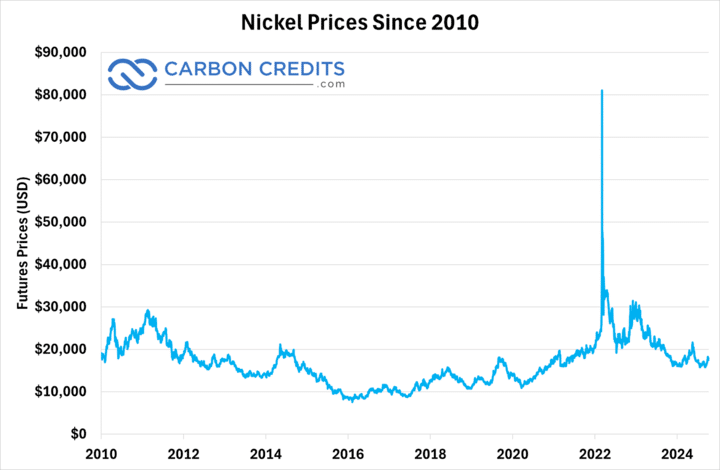
Contributing to the falling prices have been a dimming global economic outlook, which has decreased demand from stainless steel manufacturers. But remember: The new demand is from EV batteries, not stainless steel. While supply currently outweighs demand, that imbalance is not expected to last.
Macquarie Group Ltd. expects a “surprise deficit” as soon as this year if Indonesian output continues to face slow mining permit approvals. If not, the nickel market is still projected to enter a structural supply deficit as soon as next year, and that deficit is expected to widen significantly in the years to follow.
Nickel is one of two elements classified by the U.S. as having both an importance to energy and having a high-risk supply. To successfully execute the clean energy transition, the United States needs to secure a domestic source of nickel produced ethically and in an environmentally responsible manner.
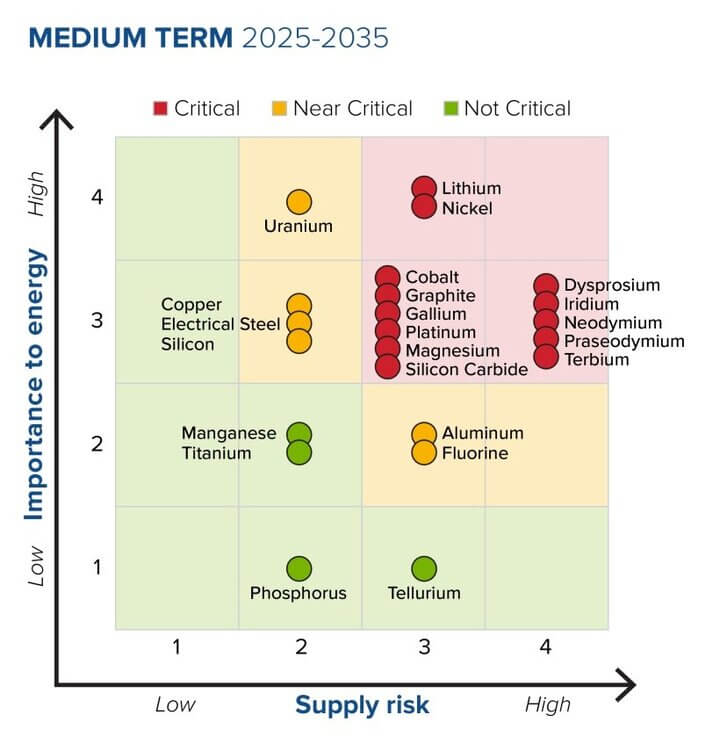
Canada usually supplies half of the U.S.’s nickel, but as Canada builds out their own battery plants, much less of their nickel is likely to make its way down to the U.S. The United States has only a single nickel mine at the tip of Michigan, though, and it is expected to close in 2025.
The solution might lie in a far-flung recess of the United States, right in the middle of Alaska. A project under development by Alaska Energy Metals could hold the key to securing a new domestic nickel supply for the United States, reducing its reliance on foreign imports and enabling a smooth transition to clean energy.
The Norilsk of North America: Alaska Energy Metals
[TSX.V: AEMC • OTCQB: AKEMF • FRA: V7F]
A targeting team from Inco, then the world’s second-largest nickel miner, had already identified an area with geologic similarities to the Norilsk region of Russia—the largest body of nickel on earth that had created the world’s largest producer of refined nickel.
His first day on the job, the geologist set foot on the Nikolai Project, where he and other geologists found nickel at surface. They drilled for five years, finding hundreds of meters of disseminated nickel sulfide mineralization, hundreds of meters wide, but the concentration was insufficient for the price of nickel at the time.
For three decades, Gregory Beischer waited. The opportunity finally came in April 2023, when he founded Alaska Energy Metals and acquired the mineral rights and all historical information to the project.
Now, a nickel story a quarter-century in the making is unfolding. And Gregory is putting his four decades of experience as a certified geologist and mining engineering technologist to work to develop a project where he knows there’s nickel.
The Nikolai Project lies near the center of Alaska, a Tier-1, pro-resource jurisdiction. It is located 80 km south of Delta Junction and 200 km southeast of Fairbanks, on the southern flank of the Alaska Range.
The project benefits from close infrastructure, with a historical mining road within 5 km and paved road access to the deep-water Port of Valdez and the Alaska Railroad within 100 km.
Thirty years ago, a geologist was sent to that Alaskan project to find nickel.
A targeting team from Inco, then the world’s second-largest nickel miner, had already identified an area with geologic similarities to the Norilsk region of Russia—the largest body of nickel on earth that had created the world’s largest producer of refined nickel.
His first day on the job, the geologist set foot on the Nikolai Project, where he and other geologists found nickel at surface. They drilled for five years, finding hundreds of meters of disseminated nickel sulfide mineralization, hundreds of meters wide, but the concentration was insufficient for the price of nickel at the time.
For three decades, Gregory Beischer waited. The opportunity finally came in April 2023, when he founded Alaska Energy Metals and acquired the mineral rights and all historical information to the project.
Now, a nickel story a quarter-century in the making is unfolding. And Gregory is putting his four decades of experience as a certified geologist and mining engineering technologist to work to develop a project where he knows there’s nickel.
The Nikolai Project lies near the center of Alaska, a Tier-1, pro-resource jurisdiction. It is located 80 km south of Delta Junction and 200 km southeast of Fairbanks, on the southern flank of the Alaska Range.
The project benefits from close infrastructure, with a historical mining road within 5 km and paved road access to the deep-water Port of Valdez and the Alaska Railroad within 100 km.
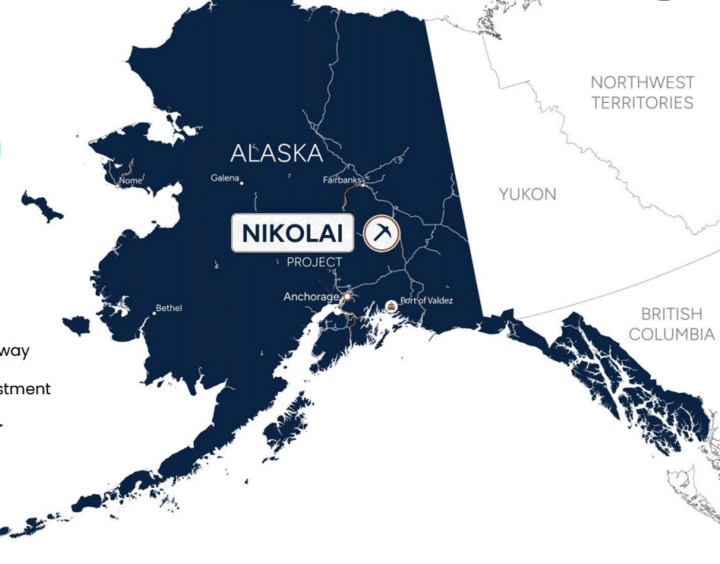
It comprises two claim blocks:
- Eureka Claim Block: 106 mining claims covering 16,960 acres (6,863 hectares) – owned outright.
- Canwell Claim Block: 59 mining claims covering 9,440 (3,820 hectares) – option to purchase 100%.
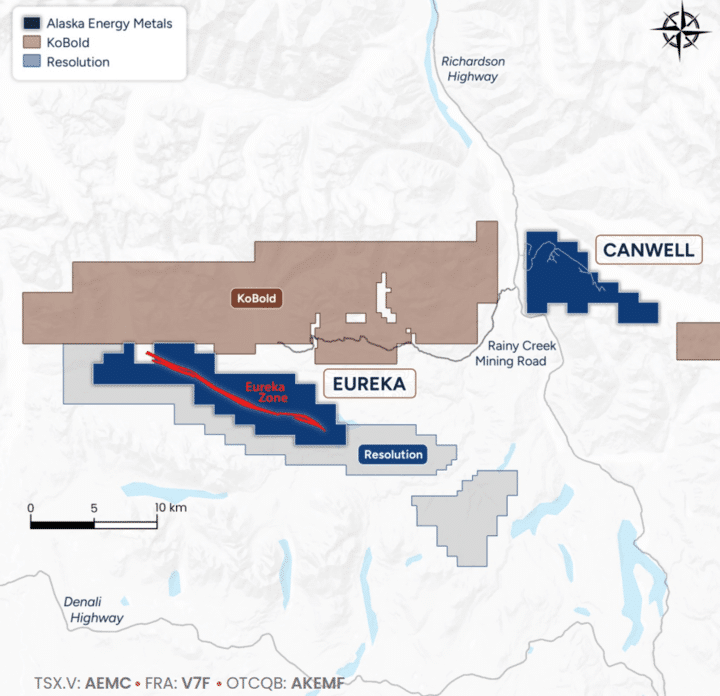
Discovery at Eureka
AEMC published an NI 43-101 mineral resource estimate for the Eureka deposit in early 2024. It shows 4.2 billion pounds of nickel in the Inferred Resource category, and 3.9 billion pounds of nickel in the Indicated Resource category, more than double what was expected. The resource estimate also confirms the presence of a treasure trove of energy transition metals: copper, cobalt, platinum, and palladium.
Eureka Indicated Resource | Eureka Inferred Resource |
|---|---|
3.871 billion pounds of nickel | 4.225 billion pounds of nickel |
1.276 billion pounds of copper | 1.040 billion pounds of copper |
303 million pounds of cobalt | 327 million pounds of cobalt |
4.0 million ounces of PGE (Pt & Pd), plus gold | 3.4 million ounces of PGE (Pt & Pd), plus gold |
5.177 billion pounds of NiEq metal | 5.406 billion pounds of NiEq metal |
The mineralization at Eureka starts at the surface, extends to at least 600 meters, and could have a strike of at least 12 kilometers.
This year, the exploration strategy will focus on increasing resource grades in Eureka. Initial drilling aims to expand inferred tonnage, specifically targeting rock samples with impressive grades of 0.89-1.0% Ni along the strike.
A higher-grade core, present over the southeastern half of the deposit, has been clearly confirmed and identified. The higher-grade core is open to the southeast. The planned 2024 drill program (1,000 meters) will drill test this higher-grade core zone along one kilometer of strike length to the southeast of the current mineral resource estimate.
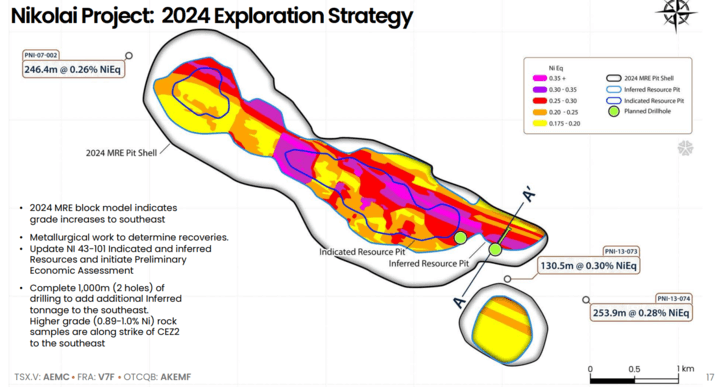
High-Grade Potential at Canwell
With Eureka proved out, AEMC is advancing its exploration efforts on the Canwell Block. Recent surface sampling has revealed zones of massiwve and disseminated sulfides, with exceptionally high concentrations of nickel, copper, and precious metals like platinum and palladium.
The 2023 exploration program identified four high-priority drill targets for 2024: Upper Canwell, Odie, Glacier Lake, and Emerick. The proposed drilling program encompasses 1,500 meters of drilling to test these prospects.
The Odie Prospect showcases a strong magnetic conductive zone linked to nickel-copper occurrences at the surface. Previous drilling may have missed deeper, high-potential zones, prompting AEMC to execute a 1,200-meter drilling program to explore these targets fully. Results are expected to be published soon.
An All-Alaskan Team
Alaska Energy Metals is led by a group of people who are true Alaskans and experts in their field.
- Kyle Negri, a certified professional geologist with fifteen years of experience in Alaska, is the VP of exploration. Mr. Negri holds expertise in drill campaign execution, team management, exploration, data management, QA/QC, targeting, and modeling.
- The board of directors is chaired by Corri Feige, a geophysicist and engineer with more than 35 years of experience in the mining, oil, and energy sectors. As the former Commissioner of Natural Resources in Alaska (2018-2022), Ms. Feige provides a strong resource on Alaskan mine permitting.
- Director Tyron Breytenbach spent a decade as a geologist specializing in exploration, resource estimation, and grade control, before transitioning into the capital markets as an equity analyst at Cormark Securities and Stifel Canada. His combination of investment and geology experience make him instrumental in raising money for Alaska Energy Metals.
- Director Mark Begich is a former U.S. senator from Alaska and former mayor of Anchorage who has been a strong advocate for responsible resource development in the state. He brings a deep understanding of local, state, and federal policymaking to the board.
Together with Gregory Beischer, this team is building out what could be a largescale North American nickel deposit, just as demand for nickel is rising.
AEMC is in a strong financial position, with CAD $1.5 million in cash on hand and no debt. This gives the company the ability to focus on advancing its exploration programs without the immediate need to raise more capital to fund near-term activities.
Despite low nickel prices, AEMC has executed a series of financings to fund its drill and exploration programs, and has used that financing with prudence. Its discovery cost per pound of nickel at Eureka was one-tenth of a cent.
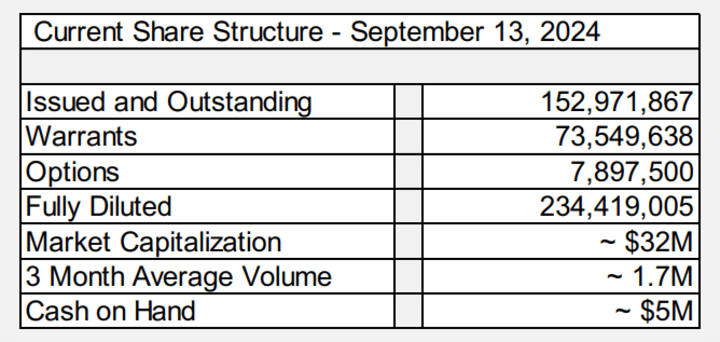
With 234 million shares fully diluted, AEMC is set for growth as more investment opportunities come along through options and warrants.
Over the next year, the Alaska Energy Metals team plans to execute access upgrades to the project, perform definition drilling and an environmental baseline study, and possibly publish a PEA/PFS.
Long-term, it plans to use its funds to develop the Nikolai Project into a largescale, open-pit mine that provides the majority of the U.S.’s nickel.
Ultimately, the homogeneity and depth of the resource indicate the possibility of a multi-decade deposit, making Alaska Energy Metals an ideal takeout candidate by a major mining company.
What’s Next for AEMCText
While AEMC has made significant progress in the past eighteen months, that has not yet translated to a share price increase. The low price of nickel could provide a window of opportunity for investors before further developments. Expansion of the Eureka deposit or the discovery of high-grade nickel sulfide there or at Canwell could significantly enhance AEMC’s resource base.
AEMC also owns the Angliers nickel project in Quebec, which holds promise for high-grade nickel-copper mineralization. A phased exploration program is set for fall 2024, focusing on data reprocessing and ground surveys to identify the best exploration targets.
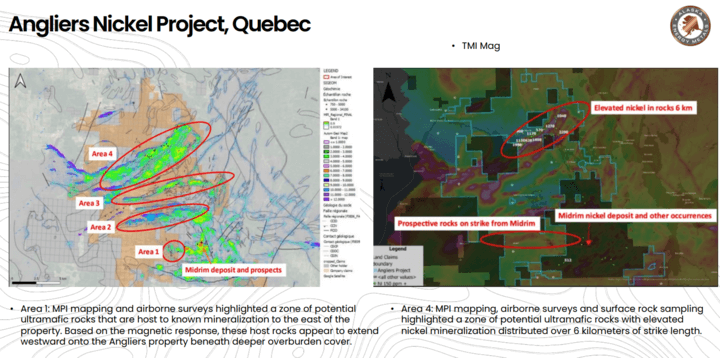
For investors, AEMC offers a unique opportunity with a low valuation and solid growth potential. There are multiple near-term catalysts for the share price in the next few months, including drill results from Canwell, resource estimates, and metallurgical studies.
Nickel is vital for the U.S. energy transition, and the Nikolai Project demonstrates significant potential to become a major North American nickel supplier. Alaskan Energy Metals presents a compelling investment opportunity in the rapidly expanding battery metals space.
“Uncovering the materials of tomorrow responsibly, while generating superior returns and putting the communities in which we work, first.
Carboncredits.com
STOCK SPOTLIGHT:
Alaska Energy Metals
(TSX.V: AEMC) (OTCQB: AKEMF) (FRA: V7F)
6 Reasons To Put Alaska Energy Metals On Your Radar
- Experienced Alaskan Management Team: Led by Alaskan Greg Beischer, a seasoned exploration geologist and executive, and supported by a technical team of fellow Alaskans, the company possesses a skilled and experienced management group capable of diligently executing complex exploration programs.
- A Domestic Source of Nickel for an Electric Energy Expansion: The Nikolai project offers the potential to become a significant, secure, domestic source of nickel, aligning with the increasing demand for nickel in an electric energy transition.
- Drilling Confirmed a Large Accumulation of Nickel: Recently completed (2023) and historical drilling results have confirmed the presence of a substantial Mineral Resource Estimate containing nickel, copper, cobalt, platinum, palladium, and gold.
- Near-Term Drilling And Resource Calculation Catalysts: Planned 2024 program has potential to expand the Eureka deposit and increase the grade. There is potential for an exploration discovery of Ni-Cu-PGE massive sulfides at the Canwell Prospect.
- Strong Financial Backing: Working with Commodity Partners of Vancouver, Canada, the company has secured quality financial backers, ensuring a well-capitalized position. A robust marketing presence will be utilized to increase awareness of the company and its project among investors.
- Favorable Jurisdiction and Infrastructure: Operating in Alaska (a tier-1, pro-resource jurisdiction) provides a favorable regulatory environment and stability for mining operations. The project benefits from a favorable infrastructure setup, paved highways traversing the project area, gravel road access, and proximity to main rail and grid power systems.
DISCLOSURES/DISCLAIMERS
Investing in stocks is HIGH RISK. You could lose All of your investment
CarbonCredits.com, as a publisher, is not a broker, investment advisor, or financial advisor in any jurisdiction.
Please do not rely on the information presented by CarbonCredits.com as personal investment advice.
If you need personal investment advice, kindly reach out to a qualified and registered broker, investment advisor, or financial advisor.
The communications from CarbonCredits.com should not form the basis of your investment decisions. Examples we provide regarding share price increases related to specific companies are based on randomly selected time periods and should not be taken as an indicator or predictor of future stock prices for those companies.
Alaska Energy Metals Corporation has sponsored this report.
The information in this newsletter does not constitute an offer to sell or a solicitation of an offer to buy any securities of a corporation or entity, including U.S. Traded Securities or U.S. Quoted Securities, in the United States or to U.S. Persons. Securities may not be offered or sold in the United States except in compliance with the registration requirements of the Securities Act and applicable U.S. state securities laws or pursuant to an exemption therefrom.
Any public offering of securities in the United States may only be made by means of a prospectus containing detailed information about the corporation or entity and its management as well as financial statements. No securities regulatory authority in the United States has either approved or disapproved of the contents of any newsletter. CarbonCredits.com nor any employee of CarbonCredits.com is not registered with the United States Securities and Exchange Commission (the “SEC”): as a “broker-dealer” under the Exchange Act, as an “investment adviser” under the Investment Advisers Act of 1940, or in any other capacity. CarbonCredits.com, its owners, directors, and employees are also not registered with any state securities commission or authority as a broker-dealer or investment advisor or in any other capacity.
HIGHLY BIASED:
In our role, we aim to highlight specific companies for your further investigation; however, these are not stock recommendations, nor do they constitute an offer or sale of the referenced securities. CarbonCredits.com has received cash compensation from Alaska Energy Metals Corporation and is thus extremely biased. It is crucial that you conduct your own research prior to investing. This includes reading the companies’ SEDAR and SEC filings, press releases, and risk disclosures. The information contained in our profiles is based on data provided by the companies, extracted from SEDAR and SEC filings, company websites, and other publicly available sources.
CarbonCredits.com, and its directors, employees, and members of their households directly own or may own shares of Alaska Energy Metals Corporation (AEMC). Therefore, CarbonCredits.com is extremely biased. Measures are in place such that no shares will be sold during the active awareness campaign.
HIGH RISK:
The securities issued by the companies we feature should be seen as high risk; if you choose to invest, despite these warnings, you may lose your entire investment. You must be aware of the risks and be willing to accept them in order to invest in financial instruments, including stocks, options, and futures.
NOT PROFESSIONAL ADVICE:
By reading this, you agree to all of the following: You understand this to be an expression of opinions and NOT professional advice. You are solely responsible for the use of any content and hold CarbonCredits.com, and all partners, members, and affiliates harmless in any event or claim. While CarbonCredits.com strives to provide accurate and reliable information sourced from believed-to-be trustworthy sources, we cannot guarantee the accuracy or reliability of the information. The information provided reflects conditions as they are at the moment of writing and not at any future date. CarbonCredits.com is not obligated to update, correct, or revise the information post-publication.
FORWARD-LOOKING STATEMENTS:
Certain information presented may contain or be considered forward-looking statements. Such statements involve known and unknown risks, uncertainties, and other factors that may cause actual results or events to differ materially from those anticipated in these statements. There can be no assurance that any such statements will prove to be accurate, and readers should not place undue reliance on such information. CarbonCredits.com does not undertake any obligations to update the information presented or to ensure that such information remains current and accurate.
TOP NEWS
